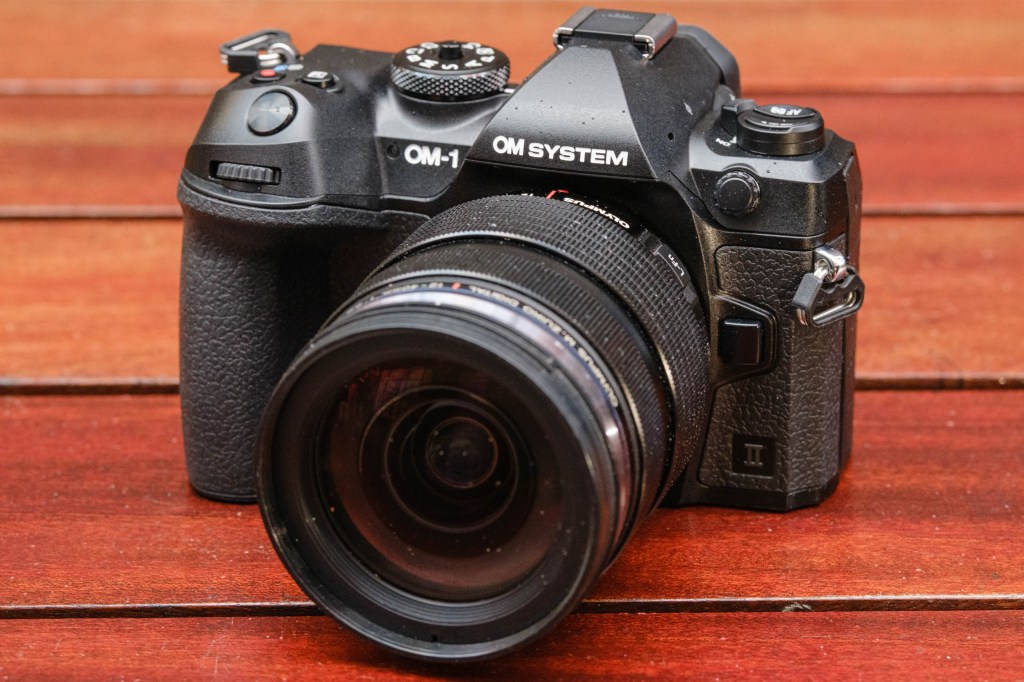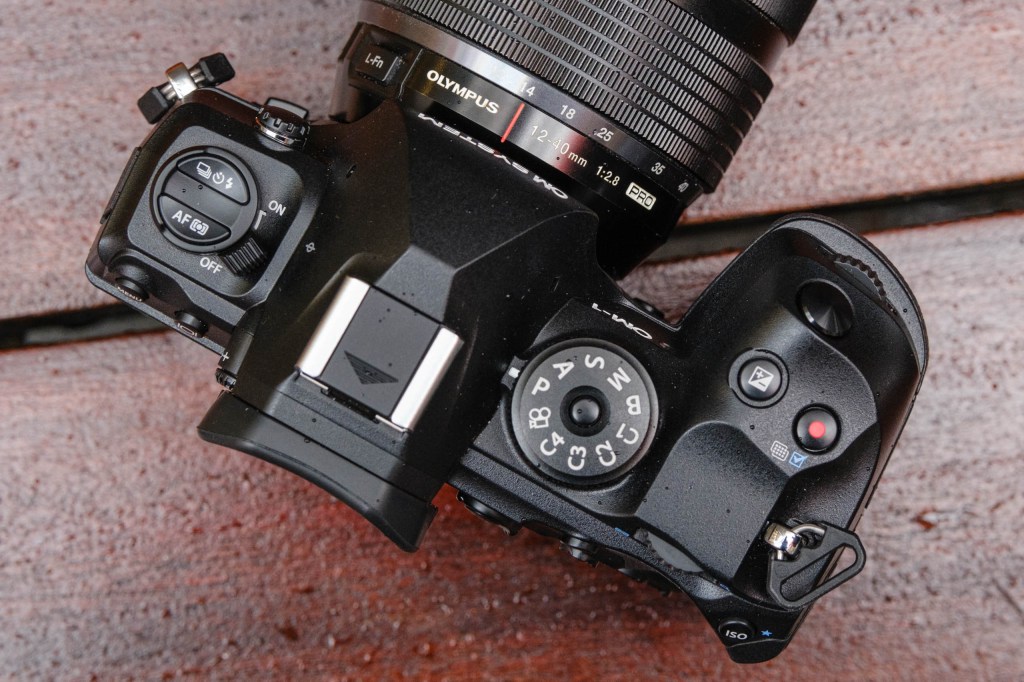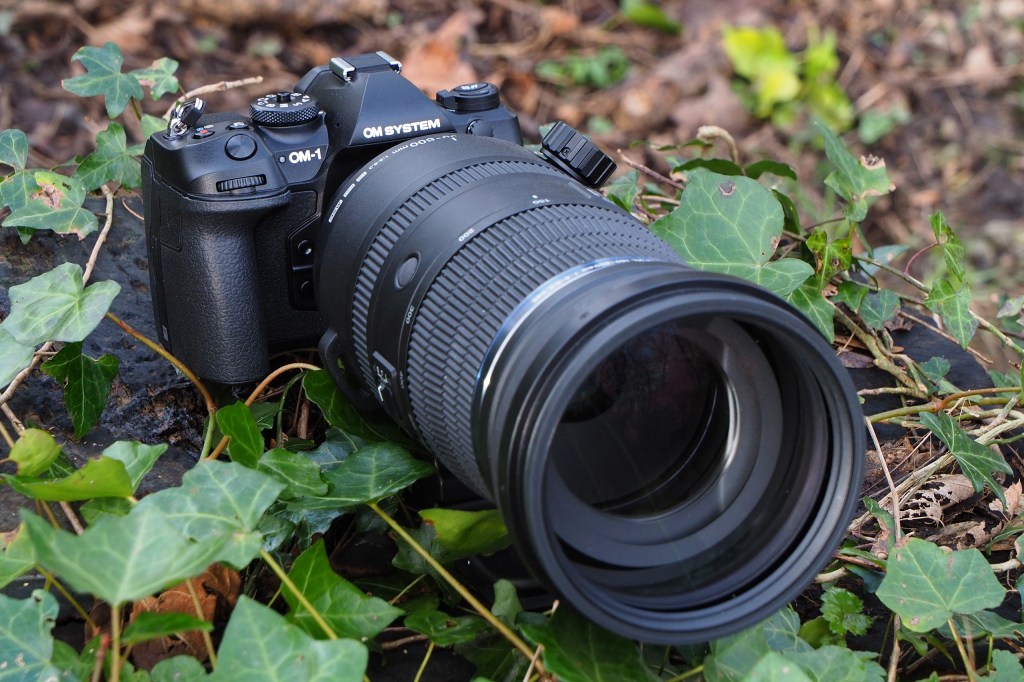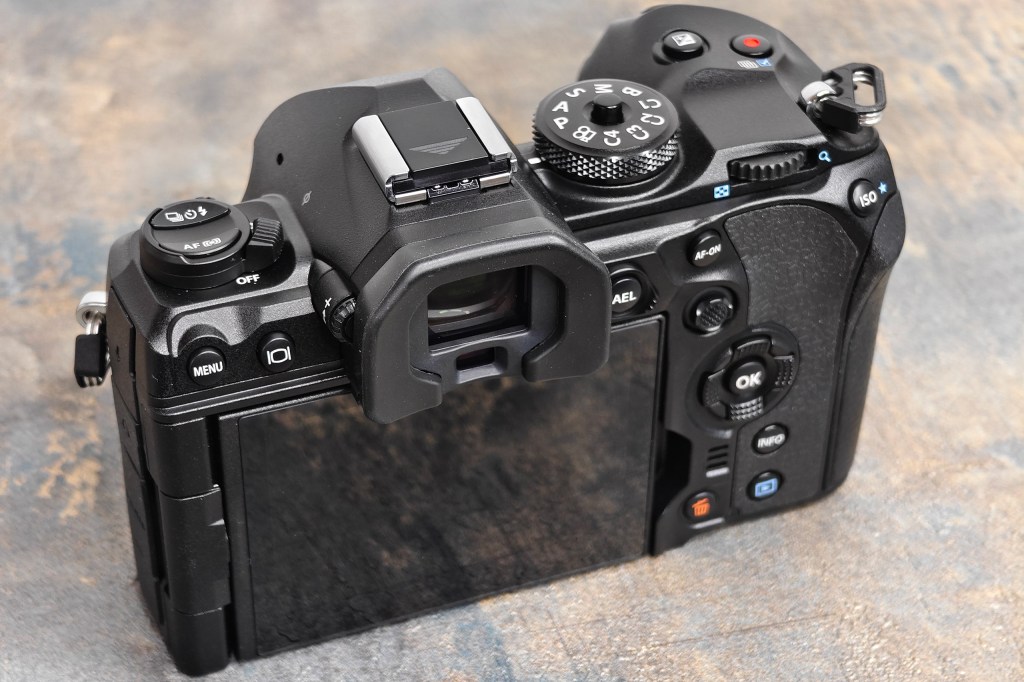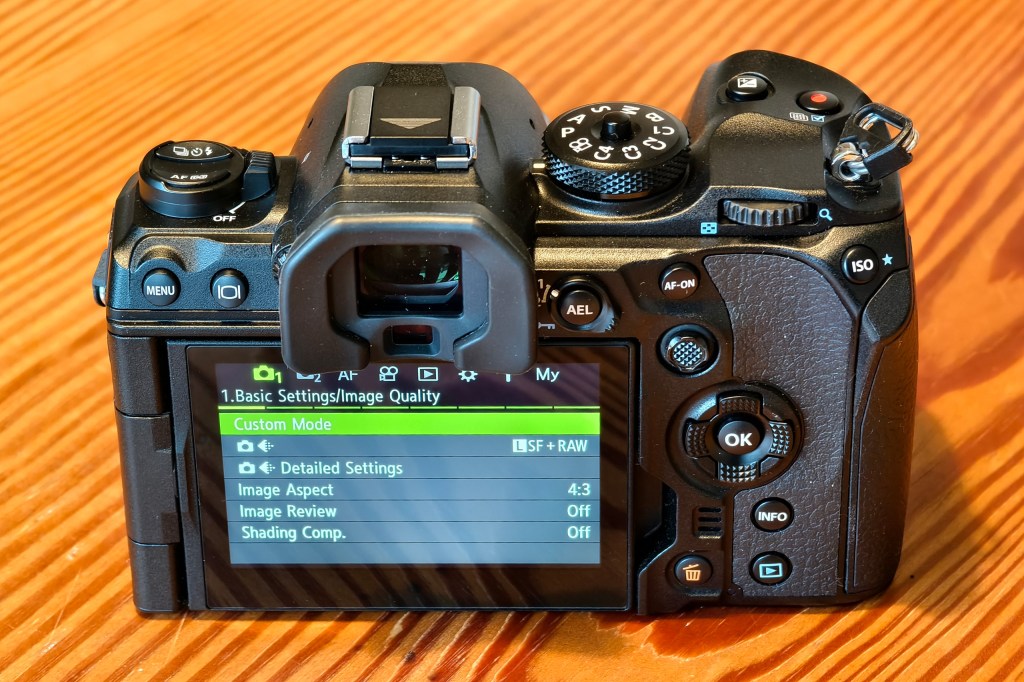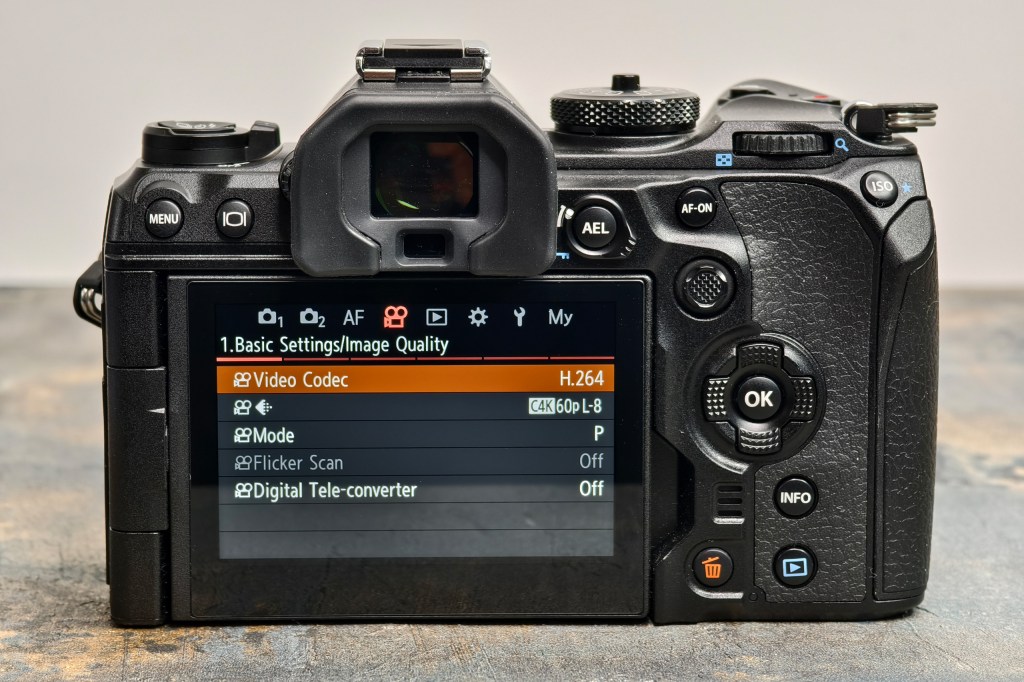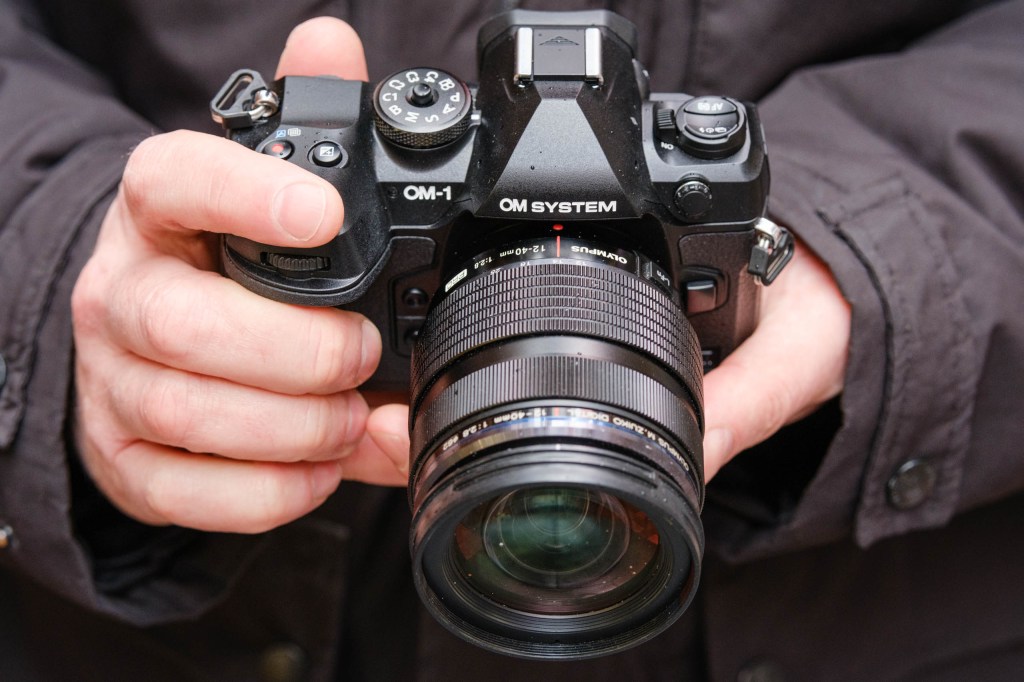Amateur Photographer verdict
The OM System OM-1 Mark II is a subtle evolution of the OM-1, which is already an impressive high-speed camera. This Mark II is even better – and graduated Live ND is a unique feature!- Computational photography is steps ahead of any other camera company
- Live Grad ND is impressive
- Improved buffer and improved IBIS
- Quicker access to subject detection settings
- 20MP 120/50fps continuous shooting (AF-S/AF-C)
- Weather sealed IP53 rating
- Videographers may not be totally satisfied
- Some small on-screen icons
- 4K 120fps would be nice
At a glance:
- $1,999 / £2,149 body only
- 20MP Four Thirds Stacked BSI Live MOS sensor
- 50fps with C-AF, 120fps fixed AF with extended buffer
- ISO80-102,400 (same)
- 1,053-point AI detect Quad Pixel AF improved, plus added human detection
- 5.76m-dot electronic viewfinder, 0.83x magnification
- 1.6m-dot 3inch vari-angle touchscreen
- 5-axis in-body stabilisation (8.5EV with Sync IS)
The new OM System OM-1 Mark II is the latest flagship camera from OM System, and updates the original OM-1. With high-speed continuous shooting, a weather-sealed camera body and new computational features, is this the most advanced and therefore best Olympus camera ever made?
At first glance the OM System OM-1Mark ll doesn’t look very different to the original OM-1. However, there are a number of differences to be found in the camera, as well as rubber-coated command dials to aid with handling.
Stand-out features:
- Live Grad ND filter – World’s first in-camera live graduated ND filter
- Hi-Res multi-shot now supports 14-bit raw recording
- Double the buffer size for increased continuous shooting (up to 256 raw shots)
- Improved continuous AF performance
Features – In detail
More than two years have passed since the OM-1 was first announced, and those familiar with it will have a head start in understanding its successor. We’ll start with some of the changes introduced in the Mark II.
New features include the World’s first Live Graduated ND filter, which is built-in to the camera. The LiveND filter has been improved with an added stop. The high-resolution multi-shot mode now supports 14-bit raw shooting.
For fans of continuous shooting, the buffer is now double the size, allowing for up to 213 raw shots at 120fps; and up to 256 raw shots when shooting at 50fps with continuous AF. The AF system has also been improved with better tracking as well as better AF during video. Subject detection was already quite impressive with cars, planes, trains, birds, and dogs and cats all recognised – now human detection has been added too.
There are a number of other improvements, including in-body image stabilisation (IBIS) which now can compensate for up to 8.5 steps. The command dials have been improved, with a rubber coating to aid grip, and the blackout free shooting has been improved as well.
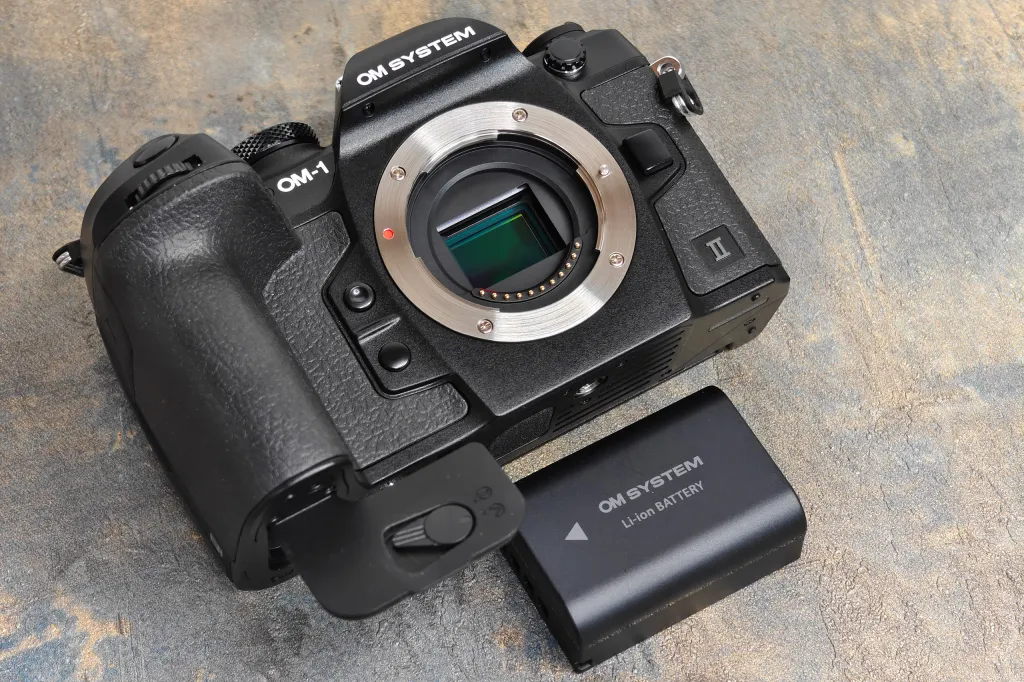
Updates compared to the OM-1:
- Live Grad ND filter (adjustable)
- Improved LiveND – with an added stop, now up to ND128 (7EV)
- Hi-res multi-shot now 14-bit RAW
- Double buffer size allows for more continuous shots (up to 213 raw at 120fps, 256 raw at 50fps C-AF)
- Improved continuous AF – improved tracking, as well as improved video AF performance
- Human detection added, with improved subject selection (pick from 8)
- Improved IBIS, now up to 8.5 steps (a 20% improvement)
- Rubber dials improves handling
- Blackout free shooting improved for slower continuous shooting speeds
- Improved in-camera focus-stacking/bracketing algorithms (up to 15 shots stacked internally)
- Supports vertical video
The core specifications of the camera remain the same: there’s still the ultra-high-speed 20MP Four Thirds sensor, which uses a Stacked BSI CMOS sensor. This allows for full-resolution shots at 120fps with fixed AF, or 50fps with continuous AF.
Still amongst the fastest cameras in the world, and in comparison, the Nikon Z8/ Nikon Z9 switches to 11MP when shooting at 120fps (albeit with AF) – and for higher resolution, you’d need to look at the 24MP Sony A9 III, with 120fps and continuous AF; at a price of 3x higher.
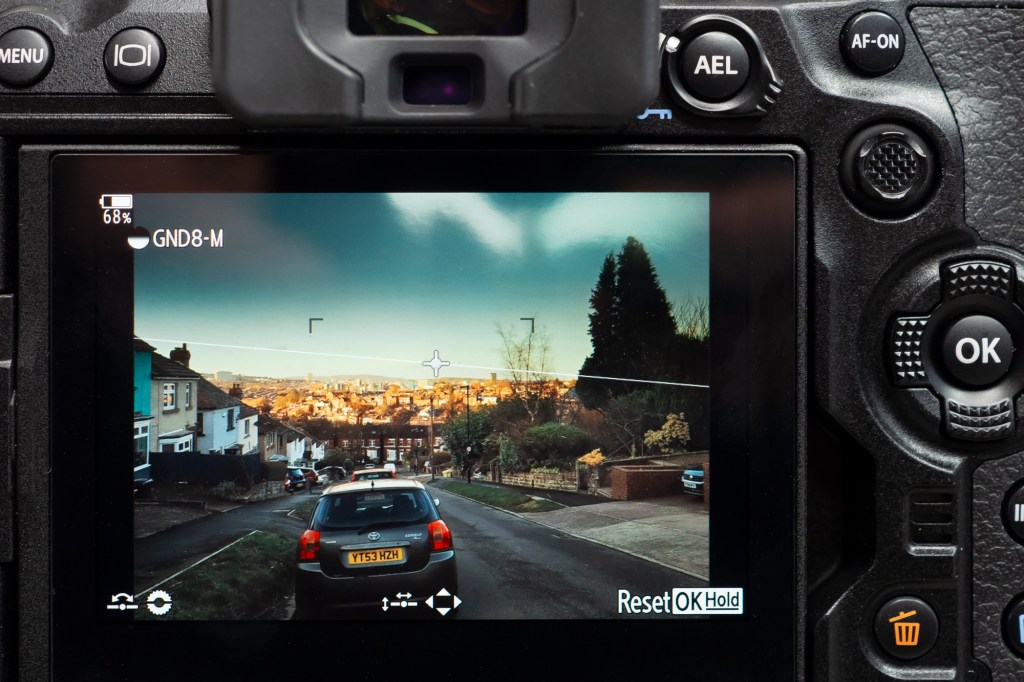
The new Live Grad ND filter gives you a number of options including GND2/GND4/GND8 (1,2,3EV), as well as soft, medium and hard filter type settings. Once switched on, you can move the position of the grad ND filter, as well as adjust the angle, with the display updating in real time so you can preview the settings. The front command dial gives quick adjustments, whereas the rear dial gives more precise adjustment, and you can also use the touchscreen to reposition the line.
You can also set the delete button as a second “Menu” button to give quicker access to the menus; great when holding the camera in one hand, without having to reach over to the top left of the camera.
Design and Handling
If you’ve read our Olympus OM-1 review, then you’ll know what this camera is about for the most part. If not, take it from us that the newer OM-1 Mark II offers the same great handling as the OM-1, with some very minor tweaks.
These tweaks are small but significant, as they do improve the handling and operation of the camera. You can move the menu and map this to the delete button, meaning you can much more quickly access the menus. This is a welcome change and well worth setting up.
The other change is that the front and rear command dials are now rubber coated, and this helps with grip, especially when wearing gloves. I never found any issue with the original dials, but this will definitely help when shooting in wet weather or slippery conditions.
There’s a large handgrip and this makes the camera a great choice for use with larger lenses when needed. There’s a great area on the back for your thumb to grip on to as well. In terms of ergonomics, there’s very little to dislike, and the ability to move the Menu button helps as well.
Controls
The OM-1 Mark II, like the OM-1, and the E-M1 Mark III before that, is setup with the photographer foremost in mind: controls are where you expect them, with quick access to some of the most commonly used photo shooting features.
The camera is IP53 rated. When used with weather-sealed lenses, this means you can use it in weather conditions that would normally be avoided. The body is very well-made, with a really solid construction, that should see the camera performing reliably for many years to come. The body weighs 599g with battery and memory card, which is the same as the original OM-1 (Mark I).
Battery life is rated at 520 shots, according to CIPA standards, however, if you switch on Quick sleep power saving mode, this is extended to 1100 shots. However, if you’re shooting using one of the high-speed continuous shooting modes, then you’ll most likely get even more shots. The camera also supports USB charging, as well as USB power delivery.
Viewfinder and screen
The electronic viewfinder (EVF) looks great, with a high-resolution OLED display at 5.76m-dots. It gives a very clear view, and the optics used are also of high quality, affording a sharp view right into the corners. Icons and text are clearly displayed, and you can access the menus and Super Control Panel if needed to change settings. You get the choice of 0.83x magnification, filling the frame, or 0.74x if 0.83x is too large. The optics have an anti-fogging coating, to help with visibility when using it in inclement weather, and there’s a 120fps / 0.005s refresh rate available.
Blackout free shooting (on the OM-1) was available at the fastest continuous shooting speeds of 120fps/50fps, but wasn’t available at lower speeds, this is now available at slower continuous shooting speeds on the Mark II, including 25fps, 16.7fps and 12.5fps.
A simulated OVF (optical viewfinder) view is available, or S-OVF, and this is designed to give you a view more similar to using an optical viewfinder. The “Night Vision” option is designed to support astrophotography, and this also works with the “Starry Sky AF” setting.
There’s a fully articulating 3inch 1.62m-dot touch-screen, which can be tilted out to face forwards, great for selfies, vlogging, and other uses. The view is very clear, and colours look great, matching the viewfinder. The screen also has good viewing angles, and is bright enough outdoors, with adjustable brightness levels.
The microphone socket can be used without the screen bumping into it, due to a high position, although unfortunately the same can’t be said for the headphone sockets and other ports below this. There’s a micro HDMI connection, rather than a full-size HDMI port.
The menus looks good but, as is the case with most camera companies, there’s no search function. If you want to find something and don’t know where to look, you can spend a long time looking through every screen (or consult the manual). It really is time for camera menus to come with a search function. However, quicker access to menu items can set up by adding them to MyMenu.
Auto-Focus
The subject detection settings have now been added to the Super Control Panel, making it quicker to access and change these settings. It would be really nice if this update was added to the OM-1, as it makes it much easier to access the settings, improving the enjoyment of using the camera.

The improved AF tracking is impressive, with the camera doing an excellent job of tracking even small subjects, such as birds. Subject detection AF and tracking is also available in the video mode.
You do still need to set the subject before shooting, and it’s unfortunate that it doesn’t automatically detect the subject type, as found on some other cameras. If you are on the wrong subject, then the camera can still detect subjects’ faces and eyes. You can also select humans as the subject to detect, without having to go into a separate section to change the settings. It’s a minor change, but a welcome one.

You can customise the AF area, and whilst there are numerous areas already setup, you can customise and setup four different, additional focus areas. AF settings can be quickly accessed with one of the many dedicated AF buttons, and pressing the top left AF/metering button gives you access to metering options, as well as AF modes including: S-AF, C-AF, MF, C-AF + Tracking, Preset MF, and Starry Sky AF.
Performance
The OM System OM-1 Mark II is a rapid camera, with a quick switch on time. The touch-screen is responsive, and you can use the touch-screen to adjust settings on the Super Control Panel. The shutter sounds nice, and is relatively quiet. For complete silence you can switch on the electronic shutter.

Image quality and detail are both excellent, particularly at lower ISO speeds. Metering and auto white balance work really well together to give you great images straight from the camera: the only tweaks needed are if you want to adjust settings to suit your personal taste.
I have been pleased with the results straight from the camera, with little to no further editing needed. On default settings you’ll get natural looking images, but if you want more vibrant, or less saturated results, then this can easily be set up, with plenty of adjustable settings.
Colour is, as expected, very pleasing. Olympus (and now OM System) cameras have always given great colour reproduction, thanks to an excellent auto white balance system. There are multiple picture modes (or profiles) to choose from, and you can customise the sharpness, contrast, saturation, and gradation of each to your own personal preferences, if wanted.

Shooting in overcast conditions, with the new OM System M.Zuiko 150-600mm F5.0-6.3 IS lens, I used higher ISO speeds to keep the shutter speed quicker. Even when shooting with higher ISO speeds up to ISO4000, JPEG images straight from the camera show excellent noise processing.

The image stabilisation system is excellent, though by default the camera will also tend to raise the ISO and shutter speeds in low light, so if you’re happy to use the IS system more, rather than rely on higher ISO/shutter speeds, then it’s worth adjusting the camera to lower ISO speeds.
This means you’re able to get sharp shots at much slower shutter speeds than you would with other camera systems, giving you the benefit of lower noise (and cleaner detail) in images, assuming, of course, you’re not shooting moving subjects.
High-res 50MP/80MP modes
In the normal photo modes, pressing the movie record button switches the hi-res mode on and off. If you hold it and turn the rear dial you can switch between off, hi-res tripod mode, and hi-res handheld mode.
The camera combines multiple shots in camera without further processing needed, producing a higher resolution image, with 50MP images possible handheld, and 80MP images when using a tripod.
This has been updated to enabled 14-bit raw, rather than 12-bit raw, and this gives additional gradation. If you edit raw, you should be able to see the benefit in your images.
The results possible are impressive, with additional detail visible thanks to a higher resolution image. That said, any movement in the scene, such as leaves blowing in the wind, may degrade the image quality in these areas.
So, whilst this does allow much higher resolution images for still subjects, it may not answer the demands of those looking for higher resolution in other situations. However, you’re unlikely to find a camera that combines both high-speed and high-resolution, without spending significantly more money. Similarly, these cameras, as normally full-frame and much larger overall. (See the Sony Alpha A1, A9 III, and Nikon Z8/Z9).
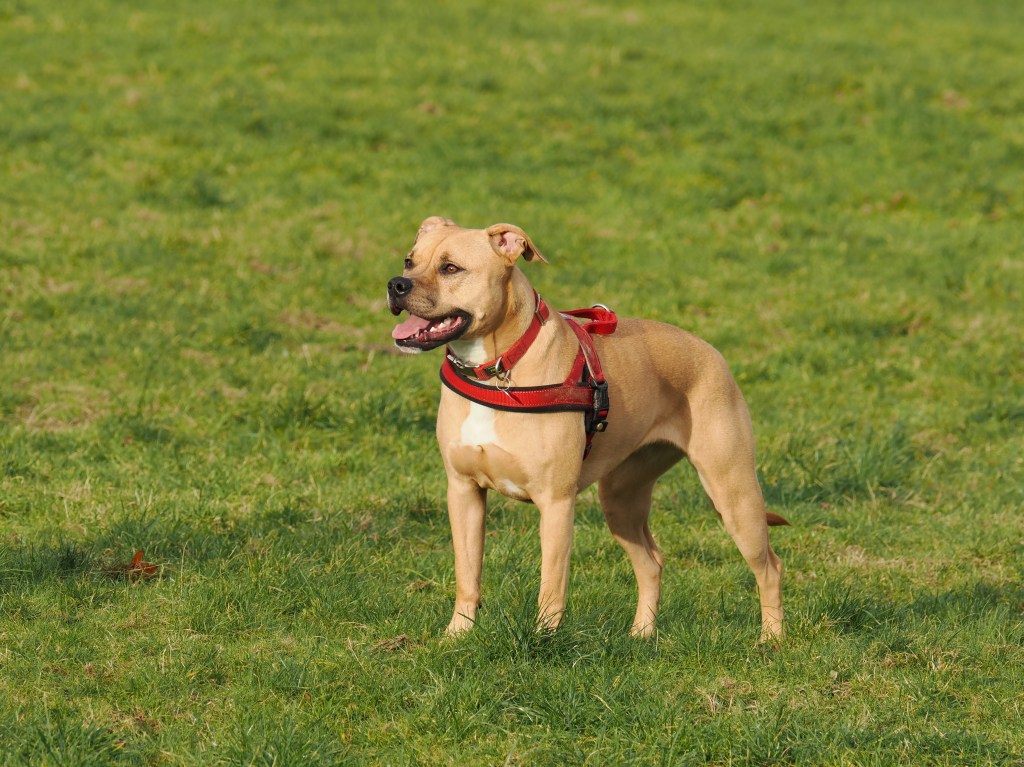
The continuous shooting mode, along with subject detection tracking was used to shoot a number of shots of this dog. Focus was consistently reliable even when the dog was moving. Using the 150-600mm lens, we were able to shoot at 25fps with continuous-AF. Using the right Olympus PRO lenses, and you’ll be able to shoot at 50fps with continuous-AF.
ISO and Noise Performance
The camera uses an AI algorithm for noise reduction, and the standard range of the OM-1 II is ISO200 to ISO25600, with ISO80, and ISO100 being extended (low) settings, and above ISO25600 being extended (high) settings, going all the way up to ISO102400. With a base ISO speed of ISO200, the extended speeds of ISO80 and ISO100 show a reduced dynamic range.
While ISO6400 felt like the limit on earlier cameras before the OM-1, such as the E-M1 III, I’d say that using ISO12800 and perhaps even ISO25600 on the OM-1 and Mark II produces much improved results. The OM-1 II delivers very good results, with JPEG images looking good, albeit with an obvious drop in detail as the ISO speed increases.
Whether you’ll want to shoot at these higher ISO speeds will be up to you, and of course, processing the raw files, you can adjust the noise reduction settings to suit.

It’s nice to see a Micro Four Thirds camera offering a competitive ISO range, making it more competitive with APS-C cameras.
You can also process raw images in-camera, to adjust the noise reduction options (Off, Low, Standard, High), or use OM/Olympus Workspace, which since the OM-1 has included AI noise reduction. Alternatively you can use Adobe’s AI noise reduction.

In-camera raw processing is available, letting you adjust a variety of settings, as well as JPEG editing features, when you’re not shooting raw.
Video recording
Video features and settings remain mostly unchanged since the original OM-1. However, OM System claim that the video AF performance has been improved, and subject detection AF is available. Webcam support no longer requires an app, and vertical video is now supported.
Video image stabilisation is excellent, though the camera is not setup in the same way as others for pure videographers, operationally. There is no video/stills switch, which would improve its operation.
4K and C4K video tops out at 60fps, whereas many alternatives, like the X-H2s, A6700, and G9 II, offer 4K at 120fps. The OM-1 Mark II offers Full HD video at 240fps, with the option for playback at 24fps for 10x slow motion video. Considering the sensor is capable of shooting 20MP stills at 120fps, it’s a shame that this isn’t an option for 4K video.
ProRes RAW 4:4:4 12bit is supported, and the camera is compatible with external devices like the ATOMOS NINJA, NINJA ULTRA, NINJA V, and NINJA V+.
OM-Log400, Flat and HLG video picture mode profiles are included, as well as the same colour profiles as the photo mode, however options are limited depending on H.264/H.265 selection, with photo profile, Flat and OM-Log400 available with H.264 (8-bit), and OM-Log400 and HLG (Hybrid Log Gamma) available with H.265 (10-bit). View Assist is available and displays a standard BT.709 colour gamut onscreen.
Detail in video footage is good, and the camera’s IBIS gives impressive stability that can give your video the look a camera mounted on a gimbal.
There are microphone and headphone sockets, as well as PD (Power Delivery) over USB Type-C. However, one thing that will most likely disappoint videographers is the micro HDMI connection, which is not as secure as a full size HDMI connection.
Value for money
The OM-1 Mark II price is currently $1,999 / £2,149, compared with the RRP of the OM-1, which was $1,399 / £1,999 body only. In relation to other APS-C and Micro Four Thirds cameras, this puts it at the more expensive end of the market, with the Fujifilm X-H2s (26MP with 40fps at $2,499/£1,899), the Panasonic Lumix G9 II (25MP, 75fps fixed, 60fps C-AF) at $1,798 / £1,689 body only. You’ll also find 26MP APS-C options available from Sony, with the Sony A6700 available for around $1,398 / £1,430 body only.
However, if you need 120fps continuous shooting, then alternatives (with Stacked BSI CMOS sensors) are considerably more expensive. This includes the Nikon Z8 at $3,699 / £2,999 (11MP at 120fps), and the Sony A9 III at $5,998 / £5,000 (24MP at 120fps).
OM System OM-1 Mark II Verdict
Gone is the Olympus branding, and introduced is a range of useful new features. Whilst not all of these changes are revolutionary, the camera has one of the fastest sensors available, with just a small handful of cameras offering such high-speed continuous shooting, and the others are notably more expensive. It’s also introduced further impressive photographic features that really do help make it an impressively compact, and capable camera system.
Playing to Micro Four Thirds strengths, there’s a relatively compact camera body, IP53 weather-sealed rating, and along with a range of compact lenses, you can now leave your grad ND filters and holders at home, and simply use the built-in feature.
The OM-1 was, and still is, an impressive camera, and the Mark II builds on that, with new features, improved continuous shooting, and a few other tweaks that make an already impressive camera even better. For some people this will be worth the cost, but others might turn to the original OM-1, especially when on offer.
The OM-1 Mark II answers a lot of the small complaints we had with the first OM-1: quicker access to subject selection AF (now on the Super Control Panel), and there are other improvements too. The menus looks good, but as is the case with most camera companies, there’s no search function, and it really is time for camera menus to develop search functionality.
With the same sensor and processing as the original OM-1, the camera gives the same high image quality as the original OM-1. This gives extremely pleasing colours, great levels of detail, and very good dynamic range.
There’s a lot to like about the 20MP BSI Stacked CMOS sensor in the OM-1 (and Mark II), as it enables the ultra-high-speed 120fps continuous shooting, and up to 50fps shooting with continuous AF, with the right lens. If OM switched to another sensor, perhaps giving higher resolution, then we’d most likely have lower continuous shooting speeds, and maybe even higher noise levels. If you do want higher resolution images, then the 50MP/80MP hi-res modes work really well.

Obviously, this isn’t a full-frame camera, but if you’re expecting OM to release a full-frame camera, then you could wait forever. There are benefits to smaller sensors, including size, speed, and price. If you do want 120fps raw from a full-frame camera, you’re going to need to spend 3x as much for a Sony A9 III.
The real question is, will these new features be tempting enough for existing Olympus/OM users to upgrade? If you already own the OM-1, then there might not be enough here, and you can rest assured knowing you already have an extremely capable camera.
With excellent subject detection auto-focus, you can rely on getting great shots from the OM-1 Mark II. It’s available now, and is both an enjoyable camera to use, with excellent handling, and has a vast range of features to explore.

See more sample photos taken with the OM System M.Zuiko 150-600mm lens
OM System OM-1 Mark II Specifications
| Sensor | 20MP Stacked BSI LIVE MOS, 17.4×13.0mm, 3.3 micron pixel size |
| Output size | 5184 x 3888 |
| Lens mount | Micro Four Thirds |
| Focal length mag | 2x |
| Stabilisation | IBIS, 5-axis sensor-shift, up to 8.5EV steps |
| Shutter speeds | 60 – 1/8000s (mechanical), 60 – 1/32000s (electronic) |
| Sensitivity | ISO 200-25600, ISO80-102400 (extended) |
| Exposure modes | PASM, B, Movie |
| Exposure comp | +/-5EV (0.3EV steps) |
| Metering | Multi-pattern, Center-weighted average, Spot metering |
| Continuous shooting | 120fps with fixed focus, 50/25fps with AF-C |
| Screen | 3in, 1.62m-dot full articulated touchscreen |
| Viewfinder | 5.76m-dots, 120fps refresh, 0.83x magnification |
| AF points | 1053, all cross-type Quad Pixel AF |
| Video | C/4K 60p, Full HD 240fps |
| External connections | Headphone, Mic, micro HDMI, USB-C |
| Memory | Dual UHS-II SD |
| Power | BLX-1 Li-ion rechargeable battery |
| Battery life | 520 shots |
| Dimensions | 138.8 x 91.6 x 72.7mm |
| Weight | 599g (with battery and memory card) |


